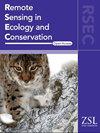豹的秘密声学世界:一对相机陷阱和生物声学调查通过它们的咆哮促进了豹的个体识别
IF 4.3
2区 环境科学与生态学
Q1 ECOLOGY
引用次数: 0
摘要
保护需要关于物种占用、数量和行为的准确信息。然而,收集这些难以捉摸的独居物种的数据,如豹(Panthera pardus),往往是具有挑战性的。利用利用不同物种特征来增加数据收集的新技术可以在更大的时空尺度上进行监测。在此,我们在坦桑尼亚尼雷尔国家公园对大型非洲食肉动物进行了首次大规模(约450平方公里)成对被动声学监测(n = 50)和相机诱捕调查(n = 50)。我们测试了是否可以通过豹子的叫声来区分它们。我们从相机陷阱图像中识别出豹子的个体,然后从并发音频中提取出它们的吼声。我们提取了豹子吼声的摘要特征,并使用2 -状态高斯隐马尔可夫模型(hmm)来模拟豹子吼声的时间模式。利用豹子吼声摘要特征,实现了个体声音识别的最高准确率为46.6%。当使用hmm来评估豹子吼声的时间模式时,个体识别更加成功,总体准确率为93.1%,宏观F1得分为0.78。我们的研究表明,使用多种技术模式,记录互补数据,可以用来发现物种特征,例如,可以从它们的叫声中识别出单个豹子。尽管需要额外的设备、数据管理和分析专业知识,配对调查仍然是一种有前途的监测方法,它可以利用更广泛的物种特征,比单一技术研究更有效地监测和通知物种保护。本文章由计算机程序翻译,如有差异,请以英文原文为准。
The secret acoustic world of leopards: A paired camera trap and bioacoustics survey facilitates the individual identification of leopards via their roars
Conservation requires accurate information about species occupancy, populations and behaviour. However, gathering these data for elusive, solitary species, such as leopards (Panthera pardus ), is often challenging. Utilizing novel technologies that augment data collection by exploiting different species' traits could enable monitoring at larger spatiotemporal scales. Here, we conducted the first, large‐scale (~450 km2 ) paired passive acoustic monitoring (n = 50) and camera trapping survey (n = 50), for large African carnivores, in Nyerere National Park, Tanzania. We tested whether leopards could be individually distinguished by their vocalizations. We identified individual leopards from camera trap images and then extracted their roaring bouts in the concurrent audio. We extracted leopard roar summary features and used 2‐state Gaussian Hidden–Markov Models (HMMs) to model the temporal pattern of individual leopard roars. Using leopard roar summary features, individual vocal discrimination was achieved at a maximum accuracy of 46.6%. When using HMMs to evaluate the temporal pattern of a leopard's roar, individual identification was more successful, with an overall accuracy of 93.1% and macro‐F1 score of 0.78. Our study shows that using multiple modes of technology, which record complementary data, can be used to discover species traits, such as, individual leopards can be identified from their vocalizations. Even though additional equipment, data management and analytical expertise are required, paired surveys are still a promising monitoring methodology which can exploit a wider variety of species traits, to monitor and inform species conservation more efficiently, than single technology studies alone.
求助全文
通过发布文献求助,成功后即可免费获取论文全文。
去求助
来源期刊

Remote Sensing in Ecology and Conservation
Earth and Planetary Sciences-Computers in Earth Sciences
CiteScore
9.80
自引率
5.50%
发文量
69
审稿时长
18 weeks
期刊介绍:
emote Sensing in Ecology and Conservation provides a forum for rapid, peer-reviewed publication of novel, multidisciplinary research at the interface between remote sensing science and ecology and conservation. The journal prioritizes findings that advance the scientific basis of ecology and conservation, promoting the development of remote-sensing based methods relevant to the management of land use and biological systems at all levels, from populations and species to ecosystems and biomes. The journal defines remote sensing in its broadest sense, including data acquisition by hand-held and fixed ground-based sensors, such as camera traps and acoustic recorders, and sensors on airplanes and satellites. The intended journal’s audience includes ecologists, conservation scientists, policy makers, managers of terrestrial and aquatic systems, remote sensing scientists, and students.
Remote Sensing in Ecology and Conservation is a fully open access journal from Wiley and the Zoological Society of London. Remote sensing has enormous potential as to provide information on the state of, and pressures on, biological diversity and ecosystem services, at multiple spatial and temporal scales. This new publication provides a forum for multidisciplinary research in remote sensing science, ecological research and conservation science.
 求助内容:
求助内容: 应助结果提醒方式:
应助结果提醒方式:


